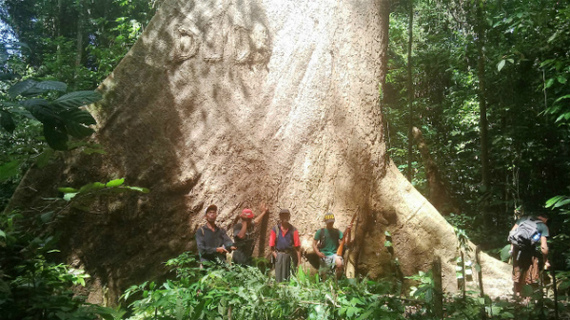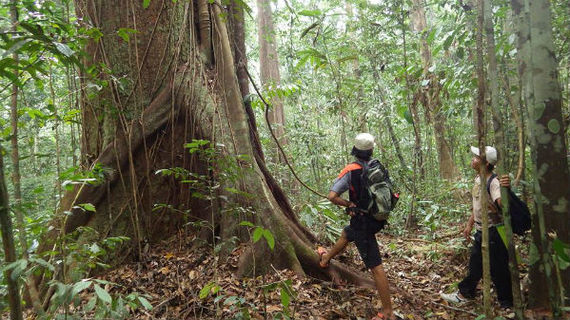"It takes a village to raise a child"
Going through the photos and reports of a flood with water levels never seen before in Tongka village, Borneo, this African proverb came to mind. There is no way a remote community in Borneo should be burdened with saving forests where trees hundreds of years old stand threatened by chainsaws and bulldozers. Not when scientists and activist groups are demanding the preservation of forests in Indonesia for our common benefit as a planet.
In these days of extreme weather where forests are said to be the best weapon in our fight against climate change, the world at large needs to come to the aid of places like Tongka village in Central Kalimantan. Tongka village is located in the district of north Barito, Central Kalimantan province in Indonesian Borneo. Village history shows the area was settled in the early 1630s by six families. Once touted as a site with potential for REDD programs, Central Kalimantan is being abandoned in favor of East Kalimantan according to this report from REDD Monitor.
This is not surprising considering the fact that most of the land in Central Kalimantan seems to be leased out to one industry or another. In north Barito's case and especially for the village of Tongka, coal mining and the timber industry represent the most immediate threats. The most well known issue on coal remains that of Australia's BHP Billington's leasehold on 350,000 hectares of land in Central Kalimantan.
This photo was taken two months ago. It's an ancient tree, know locally as "binuang" or "octomeles sumatrana". The species is not endangered as its range countries cover most countries in South East Asia but that does not mean this spectacular tree is not worthy of saving. No amount of money can replace centuries of life. What is endangered are the other tree species and wild animals that live in Tongka's forest.
Most notable are the ancient "ulin" trees, known also as "belian" in Malaysia or "Eusideroxylon zwageri" whose slow growth and exploitation has caused the Indonesian government to ban its export. A slow growing tree with a growth rate of only half an inch a year, some of the ulin trees in Tongka's forests stand over one hundred feet tall, placing their age at well over 500 years old.
My work with village NGO, The Lumbing Jewata Foundation( named after the original Dayak settler in the area, Lumbing ) over the past year has seen mapping work done to identify the areas where these ancient trees still stand. 1200 hectares have been identified and discussions have been initiated with different groups and companies to fund its protection. An application to the Indonesian government has been filed to claim these areas plus an additional 50,000 hectares for management under tribal laws but realistic expectations are that the government will grant much less.
In a power play to convince the Indonesian government that we are capable of both protecting these ancient forests and fulfilling government mandates to bring development to Indonesia's rural communities, we used funding from Lush Cosmetics to begin development activities.
A plan for tourism was made with jungle treks to see the ancient trees. Planting of high value agarwood trees was started with the purchase of one thousand agarwood seedlings. Studies were done with villagers to see if "dragon's blood" rotan was one of the thirteen species of rotans found in Tongka. Time was put into studying the cultivation of one of South East Asia's most intriguing Non-Timber-Forest-Product, the eurycoma longifolia or "pasak bumi" as it's known in Indonesia.
Challenges in saving Tongka's Forests
The reason for looking at growing high value products in Tongka village, is that it's so far away from the nearest port of export. Growing organic rice or cocoa would have been simpler but there simply isn't a market that would pay for the premiums needed to get these to consumers. I wanted to avoid fat cat middlemen in big cities whose prices would only serve to keep the villagers of Tongka in poverty.
Bringing development to the villagers will be key to the success of any efforts to protect the ancient forests in Tongka village. Amongst the villagers themselves, are rogue members who have been cutting down the ancient ulin trees in violation of Dayak customs. The binuang trees have been spared so far as Dayak superstitions say that the souls or spirits well in binuang trees. This superstition will not guarantee their survival. Tongka's forests are included in licenses that the government has granted to timber and coal mining companies. These companies will have no issues with removing an ancient tree even if it's a thousand years old.
 Ancient trees aside, the forests in Tongka are still home to most endemic Bornean wildlife including Clouded leopards and the Sunda pangolin. The flood washed away poultry and other food sources from the villagers which is causing me to squirm at the thought of increased hunting for bushmeat. Gibbons and wild fowl like the punai are still plentiful. Even sunbears and pangolins may become food or sold for cash. Wild animals are the collateral benefits I hope to gain from saving the forests in Tongka. Yet I cannot challenge these peoples rights to survival. All I can do is send in emergency supplies of instant noodles and medicine to help them get over this disaster.
Ancient trees aside, the forests in Tongka are still home to most endemic Bornean wildlife including Clouded leopards and the Sunda pangolin. The flood washed away poultry and other food sources from the villagers which is causing me to squirm at the thought of increased hunting for bushmeat. Gibbons and wild fowl like the punai are still plentiful. Even sunbears and pangolins may become food or sold for cash. Wild animals are the collateral benefits I hope to gain from saving the forests in Tongka. Yet I cannot challenge these peoples rights to survival. All I can do is send in emergency supplies of instant noodles and medicine to help them get over this disaster.
Placing forests and exotic wild animals as a priority over forest people has seldom worked to save forests unless the people are forced out. This recent report only serves to remind me that if saving endangered wild life is the ultimate goal, then we have to work with the orang hutan or forest peoples to save them.
These indigenous forests hold a key to saving Indonesia's biodiversity. In Tongka village, their forests have great potential to be a seed bank for endangered tree species like the Borneo ironwood. The IUCN Redlist on Borneon ironwood actually mentions the "inadequate supply of seeds..." as a reason for the lack of preserving this species. In an area where most of the land has been licensed out to big industry, these forests could be a last refuge for wildlife as the bulldozers and chainsaws inevitably take down the remaining forests. Invitations to conservation groups and researchers I know are yet to be answered.
Waiting for Help
The struggles got harder at Tongka village with the flood last week. Already short on funding to begin with, we will look to salvage what we can to rebuild the guest house and hope tourists will come. The agarwood seedlings will be planted once villagers recover from the disaster. Development of "dragon's blood" red resin will continue with what little knowledge we have on it as research funds were diverted to provide emergency food and medical supplies.
I hope we succeed. There's been so much said about saving Indonesian biodiversity that this ocean of words and reports could drown every remaining orangutan. Even the French bill to super tax palm oil will only be a tax grab unless they can show it being used on the ground in Indonesia and Malaysia.
There are numerous discussions and debates on saving forests within industry controlled areas but little focus on the tremendous positive impact that community forests in Indonesia can yield. This recent report indicates that over 31,000 communities in Indonesia are undergoing land fights with the government and industries. Not all of them will have the same quality of forests or a land claim as large as that of Tongka village but if we can't save the ancient forests in Tongka, then I have little hope for the rest of them.
Will the conservation minded tourist put up with the fourteen hour journey to see and save these ancient forests? Will the billions of dollars of global conservation funds ever end up being more than 1% spent on the ground? Or will destructive companies end up being saviors of forests like Tongka?
Regardless of where funding comes to save the besieged ancient forests of Tongka village, I believe we will save at least the 1200 hectares. My confidence lies in knowing that it's not some city dwelling conservationist or some corporation looking to do good that wants to save them. It's the tribal council of Tongka and supportive villagers that will achieve at least this little bit.
Readers that want to contribute to the project can make a donation towards this crowdfund Rebuilding the tourist lodge is super important to the overall campaign to save Tongka's ancient forests..
